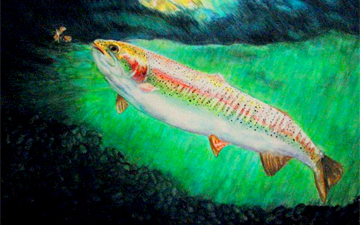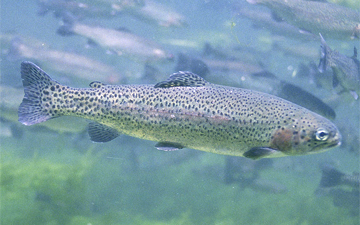The rainbow trout (Oncorhynchus mykiss) is a species of salmonid native to tributaries of the Pacific Ocean in Asia and North America. The steelhead is a sea run rainbow trout usually returning after 2 to 3 years at sea..
The species has been introduced for food or sport to at least 45 countries, and every continent except Antarctica. In some locations, such as Southern Europe, Australia and South America, they have negatively impacted upland native fish species, either by eating them, outcompeting them, transmitting contagious diseases, or hybridization with closely-related species and subspecies that are native to western North America.[1][2]
The ocean going (anadromous) form (including those returning for spawning) are known as steelhead, (Canada and the United States) or ocean trout (Australia), although they are the same species.
(From Wikipedia, May 12th , 2010)
– – –
Physical description varies widely with sex, age, and habitat. In general, they are streamlined, with 8 to 12 spines in the anal fin and lack teeth at the base of the tongue (unlike their close relatives, Oncorhynchus clarkii). The undersides tend to be silvery with a pinkish red stripe along the upper-middle part of the body, though this stripe can vary from dark to light. Resident rainbows and spawning steelhead tend to be lighter with more pronounced pink stripes, while ocean-going steelhead are darker and silvery to blend into their ocean environment. Most have black spots above the lateral line, and resident rainbows tend to have more intense spotting, well below the lateral line. Juvenile fish have 8 to 13 parr marks on their sides and become silvery as they mature. (Delaney, 2005; Gall and Crandell, 1992; Klontz, 1991; Van Hulle, 2005)
(From EOL via Animal Diversity Web)
– – –





